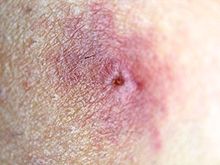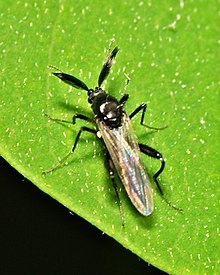Midges
| Midges | ||||||||||||
|---|---|---|---|---|---|---|---|---|---|---|---|---|

|
||||||||||||
| Systematics | ||||||||||||
|
||||||||||||
| Scientific name | ||||||||||||
| Ceratopogonidae | ||||||||||||
| Grassi , 1900 | ||||||||||||
| Subfamilies | ||||||||||||
|
Midges or bearded mosquitoes (Ceratopogonidae), regionally also g cuts , are a family of small (1 to 4 mm), mostly blood-sucking mosquitoes in the order of the two-winged mosquitoes . Around 4000 species of this group of animals live worldwide, over 190 species are known from Germany. Representatives of this group are important as vectors of bluetongue disease to ruminants.
features
Midges are mosquitoes with a strongly arched chest on the back. The wings are well developed and sometimes hairy. The mouthparts , which form a proboscis, which are sucked in together with the head together with the head , are also well developed . Some non-European species have complicated trained detention devices at the foot members ( Tarsus ). With these they hold on to the wings of dragonflies (Odonata), while the mouthparts are anchored in the wing veins of the host, as with ticks .
Way of life
The males are plant suckers. They feed on plant sap, in some species also the females. There are pollinating midges as well. The cocoa tree is even dependent exclusively on the pollination performance of species from the genera Forcipomyia and Euprojoannisia . However, the females of most species are bloodsuckers . There are species that suck the hemolymph of other insects such as Atrichopogon species that suckle on oil beetles (Meloidae) or Forcipomyia eques on lacewings of the genus Chrysopa . Other species suck the blood of birds , mammals and also humans. They can play a role as carriers of various animal diseases in the Mediterranean and Africa. Some species can become very annoying due to very painful stings and wheals at the puncture site, such as Culicoides pulicaris , and allergic reactions to the sting of midges are known.

Female midges are particularly prickly in the evening and at night. They prefer the parts of the skin on the edges of clothing, Culicoides sting in cattle on the stomach and back, in horses on the mane and tail, less often on the stomach. The host is apparently found with the help of the sense of smell. Thus one finds Culicoides often females target en masse in Arum blossoms after urine smell. Fragrances that contain amines are obviously particularly attractive in this way . The Atrichopogon oedemerarum , sucking on insects , is attracted by the cantharidin scent, the females fly to insects with cantharidin in their blood and are also stimulated by the cantharidin scent to form swarms as a meeting point with the males. At least with Culicoides , however, the host is also found optically, they are attracted by large and dark grazing animals. Cannibalism can also occur when sucking blood , so the females of the species Bezzia annulipes and Serromyia femorata suckle the male after mating. Some species can be useful as they kill plant pests, while other species suck mammalian blood from other blood-sucking insects as well.
To find a partner, the females send out sexual attractants ( pheromones ) which, especially in virgin females, have an attractive effect and induce mating on the males. The willingness of the females to mate increases with the time that has passed since the last copulation. As with most two-winged animals, the sperm is transmitted as spermatophores . Depending on the species, the eggs are partly laid on land, partly on the bank or in the water. Eggs can be laid individually, as is the case with Culicoides, or as rosettes, piles or ribbons wrapped in jelly. Dicrobezzia releases a spawning line in flight over the water. Some species lay their eggs under water.
Larval development
The larvae of the midges sometimes live on land, very often in water. They are relatively different in their appearance and can forward, often split Fußstummel and post shifter have that are sometimes armed with hooks. The land forms can be found in humus-rich soil, under bark, in deadwood , in cow dung ( coprophagia ) or in ant burrows ( ant guests ). They feed on decaying vegetable matter. Some aquatic species such as Dasyhelea also consume this form of food. The water larvae are often slender and are capable of rapid, winding swimming movements, which, however, do not guarantee very effective propulsion. They mostly prey on other insect larvae or live as ectoparasites on insect larvae and other invertebrates. The pupae live in the land forms at the place where the larvae feed, in the water forms in the mud or river bank or drifting on the surface of the water. They only have very short open breathing cones.
Transmitted Diseases
- The genus Culicoides transmits a filaria called Dipetalonema perstans (Yorke and Mapleston 1926) in Africa and also in South America , which, however, usually causes benign disease in humans.
- Bluetongue and Akabane virus (also Schmallenberg virus ) in ruminants
- African horse sickness in horses
Fossil evidence
Probably the oldest fossil evidence of a gnome comes from Lebanon amber ( Lower Cretaceous ). Further finds from the Cretaceous period go back to amber deposits from Canada and Siberia. In addition, the family has been identified from various tertiary amber deposits, including at least 24 genera and more than 100 species in the Eocene Baltic amber and five genera in the mostly somewhat younger Dominican amber .
literature
- K. Honomichl, H. Bellmann: Biology and ecology of the insects . Book and CD-Rom. Gustav Fischer Verlag, Stuttgart 1994, ISBN 3-8274-0760-5 .
- H. Mehlhorn et al .: Bluetongue disease in Germany (2007-2008): monitoring of entomological aspects. In: Parasitology Research. 105 (2), 2009, pp. 313-319. doi: 10.1007 / s00436-009-1416-y .
- S. Olbrich, A. Liebisch: Investigations on the occurrence and infestation with midges (Diptera: Ceratopogonidae) in grazing cattle in northern Germany. In: Mitt Dtsch Ges Allg Angew Ent. 6, 1988, pp. 415-420.
- C. Wesenberg-Lund : Biology of freshwater insects. Berlin 1943 (Reprint: 1980, ISBN 3-7682-1281-5 ).
- WW Wirth, WL Grogan: The predaceous midges of the world (Diptera: Ceratopogonidae; tribe Ceratopogonini). Brill, Leiden 1988, ISBN 0-916846-43-1 .
Web links
Individual evidence
- ↑ Pollinators - Chocolate midge nps.gov US National Park Service, accessed March 26, 2019. McAlister, Erica: The secret life of flies , Natural History Museum, London 2017, ISBN 978-0-565-09336-5 , pp. 43-45.
- ↑ D. Schlee, H.-G.Dietrich: Insect -bearing amber from the Lower Cretaceous of Lebanon . In: New Yearbook Geol. Paleont. Monthly books. Stuttgart 1970, pp. 40-50, cited in Poinar 1992.
- ↑ George O. Poinar, Jr .: Life in Amber. Stanford University Press, Stanford (Cal.) 1992, ISBN 0-8047-2001-0 .
- ↑ George O. Poinar, Jr., Roberta Poinar: The Amberforest. Princeton 1999, ISBN 0-691-02888-5 .

